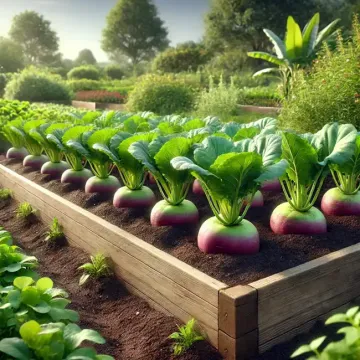Rutabagas (Brassica napus), also known as "Swedes" or "Swedish turnips," are hardy root vegetables with a sweet, nutty flavor. They are a cool-season crop, typically harvested in fall and early winter. If you’re considering adding rutabagas to your home garden, this guide will help you get started, covering everything from planting and growing tips to harvesting and storage.
History of Rutabagas
Rutabagas are believed to have originated as a cross between cabbage and turnips in the 17th century, likely in Scandinavia or Russia. They quickly became a popular crop in colder regions because of their ability to store well through the winter months. Today, they are enjoyed in various culinary traditions across the globe, particularly in soups, stews, and roasted vegetable dishes.
Health Benefits of Rutabagas
Rutabagas are packed with essential nutrients, including fiber, vitamin C, potassium, and antioxidants. They are low in calories but high in fiber, making them a great choice for supporting digestion and maintaining a healthy weight. The presence of antioxidants helps protect the body from oxidative stress and may reduce the risk of chronic diseases.
Growing Rutabagas in the Home Garden
Climate and Soil Requirements
Rutabagas thrive in cooler climates and prefer temperatures between 50°F and 70°F (10°C to 21°C). They can withstand light frosts, which can even enhance their flavor, but prolonged exposure to extreme cold can damage the crop.
For optimal growth, plant rutabagas in loose, well-draining soil with a pH between 5.5 and 7.0. Adding organic matter, such as compost, will help improve soil structure and provide essential nutrients. Rutabagas do best in full sun, although they can tolerate partial shade, especially in warmer climates.
Planting Rutabagas
Rutabagas are a long-season crop, requiring about 90 to 100 days to mature. They are usually planted in mid to late summer for a fall harvest. Here’s how to get started:
- Direct Sowing: Rutabagas are typically sown directly into the garden as they do not transplant well. Sow seeds about ½ inch deep and space them 2 to 4 inches apart in rows that are 12 to 18 inches apart.
- Thinning: Once the seedlings are about 2 inches tall, thin them to stand 6 inches apart. Proper spacing ensures the roots have enough room to grow to their full size, which is typically 4 to 6 inches in diameter.
Watering and Fertilizing
Rutabagas require consistent moisture to develop large, tender roots. Aim to keep the soil evenly moist, watering deeply once or twice a week, depending on rainfall. Mulching around the plants can help retain moisture and keep weeds at bay.
Rutabagas benefit from a balanced fertilizer, particularly one rich in phosphorus and potassium, which supports root development. If your soil is low in nutrients, consider adding a slow-release fertilizer at planting time, followed by side-dressing with compost or fertilizer midway through the growing season.
Pests and Diseases
Rutabagas are relatively hardy, but they can be susceptible to some common pests and diseases. Cabbage worms, aphids, and flea beetles are the most frequent insect pests. To protect your crop, consider using floating row covers or applying insecticidal soap as needed.
Diseases such as clubroot, downy mildew, and black rot can affect rutabagas, especially in areas with poor drainage. Crop rotation and good garden hygiene are essential in preventing these issues. Avoid planting rutabagas in the same location where other brassicas, such as cabbage or kale, were grown the previous year.
Harvesting Rutabagas
Rutabagas are ready to harvest when the roots are 3 to 5 inches in diameter. This typically occurs about 90 to 100 days after planting. For the best flavor, harvest rutabagas after a light frost but before a hard freeze. Use a garden fork or spade to gently lift the roots out of the ground, being careful not to damage them.
Once harvested, remove the tops and store the roots in a cool, dark place, such as a root cellar or refrigerator. Rutabagas can keep for several months when stored properly.
Culinary Uses of Rutabagas
Rutabagas can be prepared in various ways, making them a versatile addition to your kitchen. They can be roasted, mashed, or added to soups and stews. Their sweet, nutty flavor pairs well with a variety of seasonings, such as thyme, garlic, and butter. Rutabagas can also be used raw in salads or slaws, adding a crunchy texture.
For a classic dish, try mashing rutabagas with butter and cream, or roast them alongside other root vegetables for a hearty side dish.
Growing rutabagas in your home garden is a rewarding experience, especially if you enjoy cold-weather gardening. With the right care, you’ll be rewarded with a delicious and nutritious crop that stores well through the winter. Whether you’re a seasoned gardener or a beginner, rutabagas are an excellent addition to any garden, offering both versatility in the kitchen and resilience in the garden.

